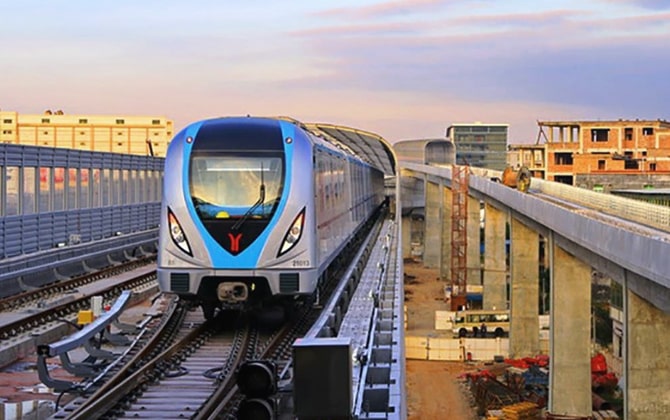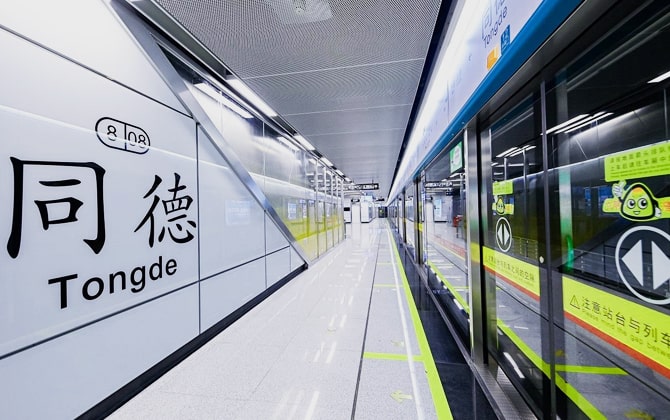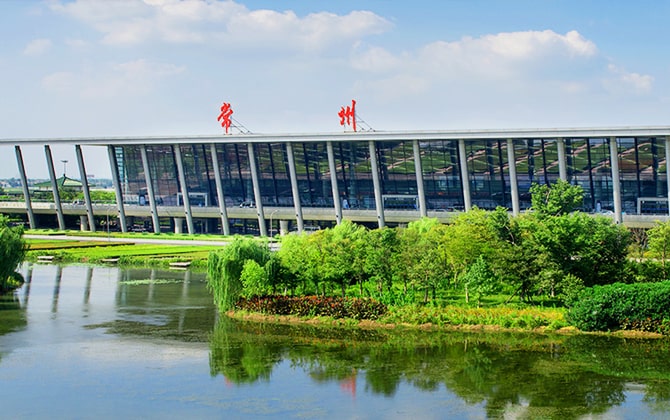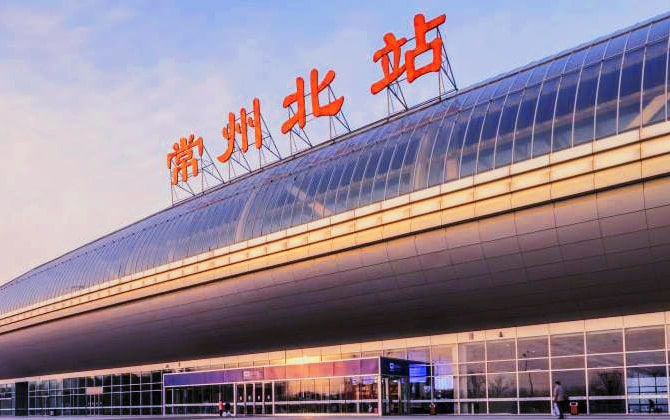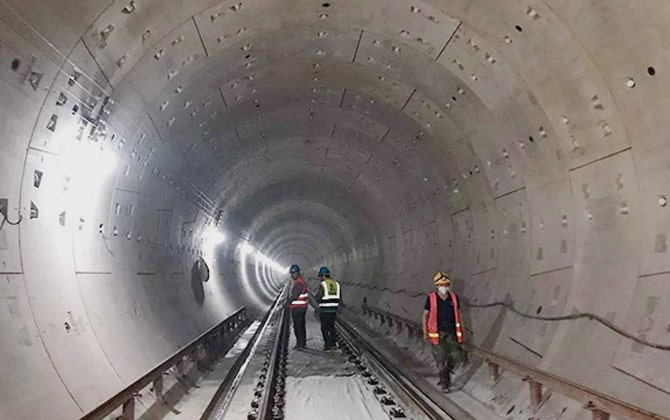The Changzhou Metro is a modern rapid transit system serving Changzhou city in Jiangsu Province, China. It opened its first line on September 21, 2019, making it the 35th Chinese city with a subway network. As of 2025, the metro has two operational lines (Line 1 and Line 2), spanning approximately 54 km (33.6 mi) and 44 stations.
The metro quickly became essential for local travel. Over 10.3 million rides were recorded in its opening year (2019), with a single-day peak of around 243,000 passengers. By the end of 2021, ridership further increased, reaching a peak daily count of approximately 267,000 passengers.
Changzhou Metro features modern 6-car trains with bilingual Chinese and English signage and announcements, providing an accessible experience for local residents and visitors alike.
Changzhou Metro Map (2025)
The official 2025 Changzhou Metro map clearly illustrates both current and future subway routes. Line 1 (north–south) and Line 2 (east–west) appear distinctly colored, with clearly labeled stations in English and Chinese. Major stations like Changzhou Railway Station, key interchanges, districts, and planned expansions (Lines 5 and 6) are also marked.
Click on the map to enlarge it or download the Changzhou subway map in PDF format.
Changzhou Metro Lines and Stations
Changzhou Metro currently operates two lines, both initially opened after 2019:
- Line 1 (Forest Park – Nanxiashu): Runs 34.24 km (21.3 mi) from the northern Forest Park (Xinbei District) down to Nanxiashu (Wujin District), serving 29 stations. Main stops include Forest Park, Changzhou North Station area (future High-Speed Rail station), Changzhou Railway Station (main railway hub), Government Center, Wujin University, and Nanxiashu.
- Line 2 (Qingfeng Park – Wuyi Road): Extends 19.79 km (12.3 mi) east-west from Qingfeng Park (Zhonglou District) to Wuyi Road (Wujin District), with 15 stations. Notable stops include Qingfeng Park, Hongmei Park, Nan Da Jie (South Street shopping zone), South City (Silicon Valley region), and Wuyi Road.
Together, these two lines cover 54.03 km (33.6 mi) and 44 stations.
| Line | Route (Termini) | Opened | Length (km/mi) | Stations |
|---|---|---|---|---|
| 1 | Forest Park (Xinbei) – Nanxiashu (Wujin) | Sep 2019 | 34.24 km (21.3 mi) | 29 |
| 2 | Qingfeng Park (Zhonglou) – Wuyi Road (Wujin) | Jun 2021 | 19.79 km (12.3 mi) | 15 |
Online station guides include all stations along with available transfers. Changzhou Railway Station (Line 1) provides convenient cross-platform transfers to intercity trains. All station names are displayed clearly in Chinese and English (Pinyin), assisting international travelers with navigation.
Changzhou Metro Schedule & Timetable
Operating Hours Today
Changzhou Metro typically operates from 06:00 to 22:00 daily on both Line 1 and Line 2. For example, as of early 2025, the first northbound train on Line 1 departs from Nanxiashu at 06:00, and the last one arrives around 22:00. Line 2 follows a similar Changzhou Metro timetable, running from approximately 06:00 until 22:00 daily. On holidays, service hours may be extended. For instance, during the May Day 2025 Golden Week, Changzhou Metro extended its last trains to 23:30. Check the metro app or station announcements for temporary schedule adjustments or extensions.
Opening and Closing Times
Most stations open around the time of the first train (about 06:00) and close shortly after the last train (~22:00). There is continuous metro operation during these hours without midday closures. Passengers are advised to board well before the final train time to avoid long waits or being stranded overnight. Metro staff and station displays provide advance notices about any schedule changes.
Frequency & Train Schedule
Changzhou Metro provides frequent, reliable services with minimal wait times:
- Weekdays (Mon–Fri): Rush-hour trains run every ~7 minutes during mornings (07:30–09:00) and evenings (16:30–18:30) on Line 1. Other daytime Changzhou Metro hours average around 8 minutes, while after 20:00 frequency decreases to about 10 minutes. Line 2 has a similar schedule, running every ~7 min during peak hours (07:00–09:00, 17:00–19:00) and ~8–10 minutes otherwise.
- Weekends: Line 1 has 7-minute intervals midday (09:00–20:00) and 8–10 minutes early morning/late evening. Line 2 offers comparable frequencies.
During special occasions or holidays, extra services sometimes run. Regular interval checks through official metro apps or station displays are recommended.
Changzhou Metro Ticket Prices & Fares
The metro uses a distance-based fare system, making it affordable by international standards. Below is an overview of typical fares:
| Distance (km) | Distance (mi) | Fare (RMB) | Fare (USD) |
|---|---|---|---|
| 0–5 km | 0–3.1 mi | ¥2 | ~$0.28 |
| 5–10 km | 3.1–6.2 mi | ¥3 | ~$0.42 |
| 10–15 km | 6.2–9.3 mi | ¥4 | ~$0.56 |
| 15–22 km | 9.3–13.7 mi | ¥5 | ~$0.70 |
| 22–29 km | 13.7–18.0 mi | ¥6 | ~$0.84 |
| 29–38 km (max on Line 1) | 18.0–23.6 mi | ¥7 | ~$0.97 |
| Beyond 38 km | Beyond 23.6 mi | +¥1 per additional 9 km segment | (additional) |
(Rates approximated at ¥7.2 = US $1.00)
Example: Traveling the full 34 km length of Line 1 costs ¥7 (~$0.97). A shorter, 12-km journey will cost ¥4 (~$0.56).
Available Ticket Types:
- Single-Ride Tokens: Disposable tokens bought from station vending machines, valid only for one trip. No discounts or transfers provided.
- Transit Cards (Longcheng/Citizen Card): Rechargeable stored-value cards that deduct fares automatically. Using the transit card grants a 5% discount compared to token fares.
- Mobile/QR Payments: Passengers can pay via WeChat Pay, Alipay, or metro apps (“My Changzhou”). Mobile payments enjoy the same 5% discount as transit cards.
- Annual Pass: Unlimited rides for one year priced at ¥900 (~$125), activated at station counters. Ideal for frequent metro users.
Note: Changzhou Metro does not offer a 24-hour or day pass option. Occasional riders or tourists typically benefit from e-payment systems or regular tokens.
Discounts for seniors, children, and students apply only with registered cards or mobile payments. Single-ride tokens and cash payments do not qualify for discounts. Check station notices for detailed rules and eligibility.
Fare Calculator
Passengers can estimate Changzhou Metro fares using these simple distance rules:
- Under 5 km (3.1 miles): ¥2 ($0.28)
- Every additional 5-9 km (3.1-5.6 miles) adds ¥1
For example, a 20 km (12.4 miles) trip costs ¥5 (~$0.70).
For precise pricing on specific journeys, use the official fare calculator available on the Changzhou Metro app or at station machines.
Ticket Types and Day Pass
- Single tickets: Available at station machines or counters with no discounts.
- Stored-value cards: Use the Longcheng City Card or Changzhou Metro Card. Simply tap in/out when traveling and enjoy ~5% discount per ride. Recharge at any station.
- Yearly pass: Pay ¥900/year ($125) for unlimited rides on Lines 1-2.
- Day pass: Not available – Changzhou does not offer a 24-hour pass option.
Bulk Changzhou Metro tickets are not commonly used. Most locals use smartcards while visitors typically opt for short-term transit cards or mobile QR payments for convenience and small savings.
How Much Does Changzhou Metro Cost?
Changzhou Metro is very affordable:
- Short ride (5 km/3.1 miles, 1-2 stops): ¥2 ($0.28)
- Medium trip (10-15 km/6.2-9.3 miles): ¥4 ($0.56)
- Long journey (20-30 km/12.4-18.6 miles): ¥6-7 ($0.84-$0.97)
These rates make the Metro significantly cheaper than taxis or private cars in Changzhou. All fares are charged in RMB. Various payment methods automatically convert currency if you fund your card with local money.
Routes and Connections
Connections with Changzhou Bus and Airport
Changzhou Metro seamlessly integrates with other transportation options:
City buses: Numerous bus routes connect at major Metro stations. Use the same Longcheng transit card for both. Enjoy a ¥1 transfer discount when switching between metro and bus within 60 minutes (card payments only).
Airport shuttle: Benniu Airport isn’t yet on the metro network. Take the airport shuttle bus from Changzhou Railway Station (Line 1 terminus), departing roughly every 2 hours. The 40-minute journey costs ¥15 ($2.10) one-way. Alternatively, taxis cover the 25 km (15.5 miles) trip for about ¥100 ($14).
Long-distance bus: The main bus terminal (客运中心) offers coaches to nearby cities and connects to the local bus network. Use your integrated fare card for transfer discounts.
Rail connections: Line 1 serves Changzhou Railway Station with high-speed trains to Shanghai, Nanjing, and beyond. Changzhou North HSR Station will connect to future metro lines.
Station maps display nearby bus lines and taxi stands for easy transfers.
Changzhou Public Transport Overview
The city offers comprehensive public transportation:
Metro: 2 lines spanning 54 km (33.5 miles) with 44 stations. Lines 5 and 6 are under construction.
Buses: Over 100 routes serving urban and suburban areas. Many electric or low-emission vehicles connect neighborhoods to metro stations.
Rail: Changzhou sits on the Shanghai–Nanjing high-speed line with additional suburban/intercity connections planned.
Airport: Changzhou Benniu Airport handles domestic flights, accessible by shuttle bus.
Other options: Public bike-sharing and taxi services complement the network. Many residents walk or bike to stations before using metro or bus.
The Longcheng Card works across all transit systems, making transfers simple and convenient.
Facilities & Services
Parking Charges per Day
Several stations offer park-and-ride facilities with these typical rates:
Nanxiashu Station (Line 1 southern terminus) provides a 76-space underground lot. Metro app users receive 50% off parking fees.
Culture Square/Hongmei Park lots: First 3 hours cost ¥5 ($0.70), then ¥5/hour with a daily maximum of ¥35 ($4.90).
Other city lots: Many offer 30-120 minutes free, then ¥3-5 ($0.42-0.70) per hour with daily caps of ¥12-30 ($1.70-4.20).
Full-day parking typically ranges from ¥12-35 ($1.70-4.90) depending on location. Always check posted signs for current rates.
Changzhou Metro Card – How to Use
The stored-value transit card offers convenience and savings:
- Purchase: Buy a Changzhou City Citizen Card or Longcheng Card at any station service counter.
- Load money: Recharge in ¥10 increments at station kiosks using cash, WeChat, or Alipay.
- Ride: Tap in/out at faregates. The correct fare is automatically deducted with a 5% discount.
- Check balance: Machines and counters display your remaining credit.
The card works on buses too and even at some local shops. China’s nationwide T-Union cards also work on Changzhou Metro.
Mobile payment options include the official “Changzhou Metro” app or “My Changzhou” city app. Link to your payment account to use QR codes at gates with the same 5% discount.
For tourists: Ticket machines offer English interfaces. Select your destination and pay with cash or card to receive a token for one-time use.
Rules & Useful Tips for Riding
Is Changzhou Metro Safe? Safety Tips
Changzhou Metro maintains excellent safety standards. All stations have security checks with X-ray scanners and metal detectors. Surveillance cameras and staff patrol the entire system, and platform screen doors prevent accidents. Incidents like theft or assault are extremely rare.
For your safety, keep belongings secure, though theft is uncommon. Hazardous materials, bulky items, and flammable goods are prohibited. Always wait for trains to stop completely before boarding or exiting.
In emergencies, find staff at customer service centers or use platform intercoms. To contact police, dial 110. Remember that smoking, eating, and drinking are not allowed on trains. Be courteous by offering seats to elderly or disabled passengers. When using escalators, stand on the right if not walking.
Guide for First-Time Users
- Buying tickets: Use machines (with English menus) or service counters. Pay with cash or mobile payments.
- Using gates: Insert tokens or tap cards/phones at readers. Keep your ticket until exiting.
- Language: Announcements and signs are in Mandarin and English. Major stations have staff with basic English skills.
- Navigation: Check line maps in stations and apps. Government Center station connects Lines 1 and 2.
- Timing and etiquette: Avoid peak hours (8-9 AM, 5-6 PM) if possible to avoid crowds. Choose numbered/lettered exits closest to your destination. Queue at marked waiting spots and allow passengers to exit before boarding. On crowded trains, move toward the middle to create space.
Interesting Facts & History
Construction of Line 1 began in October 2014, opening on September 21, 2019. Changzhou became China’s 35th city with a metro system, with the initial 34.24 km (21.3 miles) section of Line 1 completed in about 5 years.
By the end of 2024, Lines 1-2 had carried over 290 million passengers total, with busiest days seeing about 267,000 riders. The network uses modern Type-B (6-car) trains featuring red-and-gold “dragon” motifs, reflecting Changzhou’s nickname “Dragon City.”
The current network forms a “+” shape, with planned expansion to create a “井” grid pattern. The master plan envisions a 6-line, 208 km (129.2 miles) network by 2030.
Future Expansions & Upcoming Lines
Changzhou Metro is rapidly expanding beyond the initial two lines:
Line 5: Construction began in late 2024 as a key northwest-southeast corridor through downtown. Target opening: late 2028.
Line 6: Groundbreaking occurred in September 2024. Phase 1 will cover 28.9 km (18 miles) with 21 stations from Wujin Yanjiang to Changjiang North Road. Scheduled opening: around September 2029.
Future plans: Lines 3 and 4 are in development. Line 3 will connect Changzhou North HSR station to suburban Miaoqiao, while Line 4 will run east-west through Qinglong-Jianhu areas.
By 2030, Changzhou aims to operate at least 4 metro lines, with a total network of approximately 208 km (129.2 miles). These expansions will provide more direct routes, reduce transfers, and support new development zones like the West Taihu Lake area.

